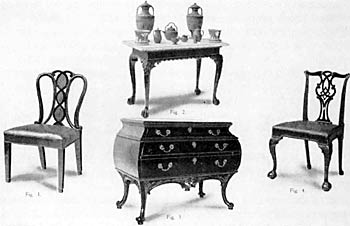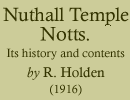Much of the furniture in the hall and gallery is worthy of notice. In the former are a set of twelve Hepplewhite chairs with painted medallions in the backs (Plate III., Fig. 1) two round mahogany tables with railed galleries, one Chippendale {circa 1760), the other, with metal rail, Hepplewhite. A Chippendale side table, with carved and shaped legs, claw and ball feet, and white marble top, circa 1755 (Plate III., Fig. 2), an empire stand, two late 17th century oak chests, two Georgian arm chairs (one on each side of the fireplace), a shaped marqueterie commode with marble top and ormulu mounts (Louis XV.), a Sheraton music stool, a pair of Hepplewhite pier tables with inlaid work and medallions. These tables and the twelve Hepplewhite chairs were probably made for the room now called the music room, but which was originally the dining room, and were bought with the house in 1819.
 |
| Plate III. |
From correspondence in the muniment room, it appears that while the Hon. G. C. Vernon inherited the Temple and estate on his father becoming Lord Vernon, the furniture belonged to the latter, who took some of it with him to Sudbury Hall. By a mistake on the part of the London lawyer, Mr. Broughton, the Temple and its contents were sold to R. Holden. The Hon. G. C. Vernon was Godfather to one of R. Holden's daughters - Catherine - who married in 1829, John Sherwin Sherwin, of Bramcote Hills, Notts., who eventually inherited Harlaxton Manor, Lincolnshire, and took the additional name of Gregory.
There are cabinets against the walls of the hall, five of them filled with china, of which there is a good collection, including Crown Derby, Worcestor, Chelsea, Wedgewood, Sevres, Dresden, and Oriental. Most of it was acquired by Colonel Robert Holden (1805-1872). The black Wedgewood on the Chippendale side table is very striking, also the Louis XV. black Boulle clock, and Cloisonne vases - Chinese, 17th century - on the mantelpiece. There are a pair of oval mirrors, with carved and gilt wood frames, by Hepplewhite, on the south and north walls. On the left hand side of the door leading to the front stairs is an English red lacquer cabinet, Chinese style, circa 1720, with doors enclosing drawers, which belonged to Mrs. Holden (1783-1840), then to her eldest daughter, Mary Anne, who married Francis Bradshaw, of Barton Blount, co. of Derby, and came to the Rev. R. Holden in 1915, on the death of the last member of that branch of the Bradshaw family.
The first door on the south of the vestibule leads to the front stairs and the lower "tent" room, probably so called from the shape of the canopy of the bed which at one period was in it. This room was originally a sitting room, but for many years has been a bedroom. In it are a mahogany gentleman's wardrobe (Hepplewhite), mahogany chest of drawers, dressing table, and commode (all Chippendale), two Hepplewhite arm chairs, two Sheraton cane-seated chairs, and a small round table - probably Queen Anne. In this room are some interesting pictures, viz:- "Beggar Boy", Dutch interior by J. Steenwych (signed), Duchess of Bolton (usually known by the name of Lavinia Fenton) attributed to Hogarth, Robert Holden (1769-1844) by Barber, his wife, Mary Anne Holden (1783-1840), the first Duke of Marlborough, portrait of a gentleman by Sir David Wilkie, also a large landscape with figures by Van de Velde, a landscape with figures and fountain - probably by Pannini, and a portrait of a gentleman - possibly by Rembrandt.
Next to this room is the library. Originally there were two rooms here opening into one another as did all the rooms round the hall. Mr. and Mrs. R. Holden, in 1820 and 1821, made the present library with a little drawing room opening into it by folding doors. The windows were altered to the French style, and the balcony, with steps into the garden, formed outside. Two windows on the south side of the little drawing room were made blank, and (unfortunately) new mantelpieces and grates set up. The length of the two rooms is fifty-seven feet. There are about 4,500 volumes, amongst them some good County histories. Amongst the furniture are three pollard oak tables on heavily carved pedestals, and a carved walnut occasional table, all of which were brought from Hempshill Hall, and are of a later date than most of the furniture in the house. Worthy of notice are two arm chairs on carved cabriole supports (Chippendale), a pair of Chippendale fire screens, a mahogany kidney-shaped table (Sheraton), four coffee tables (Sheraton), an Empire writing-table chair, a wine cooler, of which the top part is Chippendale, and the stand of a later date, and two Chippendale china tables, with fretted galleries, circa 1760. On one of these are the following miniatures:- Robert Holden, of Darley Abbey (1722-1808), Mrs. Drury Lowe, of Locko Park (1745-1848), her daughter, Mary Anne Holden (1783-1840), her son-in-law, Robert Holden (1769-1844), Mrs. Shuttleworth, nee Mary Holden, only child and heiress of Robert Holden, of Aston Hall, co. Derby (1718-1791, married 1742, James Shuttleworth of Gawthorpe, Barton Lodge, and Forcett, co. of York), also a small framed enamel of Rev. Thomas Holden (1676-1726), Rector of Aston, co. Derby, who was a direct ancestor of the family now owning Nuthall Temple. This family claims descent from one of the oldest families in England, the Holdens of Holden Hall, near Haslingden, co. Lancashire. An original parchment pedigree, in the possession of the family of Holden Hall, commences with Robert de Holdene, and deduces the descent in an unbroken chain from John Holdene de Holdene, A.D. 1189. According to Whittaker's History of Whalley, it is Saxon in origin, and derives its name from two Saxon words: "Hol" and "Dene", signifying "Hollow Valley".
The branch of the family owning Nuthall Temple settled at Wilne, in Derbyshire, in the reign of Queen Elizabeth, when Henry Holden married Alice, daughter of Robert Wilmot, of Derby and Spondon. At the beginning of the 17th century they acquired the neighbouring property of Aston Hall. At the beginning of the 18th century the Rev. Thomas Holden, second son of Samuel Holden, of Aston Hall, married Elizabeth, eldest daughter and co-heiress (with her sister Aletheia, married to Charles Salvile, of Methley, co. of York, whose only son was created Earl of Mexborough) of Gilbert Millington, of Felly Priory, co. of Notts. The Rev. Thomas Holden's great grandson sold Felley Priory in 1796. On this table are also two wax portraits, one of R. Holden, of Darley Abbey (1722-1808) taken in 1763, and said to be "very like", the other of a lady member of the family towards the latter part of the 18th century, also a brooch which belonged to Mrs. Holden (1783-1840), with twelve little pendant lockets, having the initials of each of her children, who grew up, on one side, and their hair on the other. On this table is also an elaborately carved bone watch stand, executed by the French prisoners on Dartmoor, in the beginning of the 19th century. There are portraits in oil over the book-shelves on each wall of the library. Amongst the most interesting are - on the north wall, Sir Charles Lucas, General Ireton, Oliver Cromwell, Anthony Cooper (Lord Shaftesbury), John Pym, John Drury (brother of the first William Drury Lowe, of Locko Park, and Godfather to Sophia Holden, afterwards the Hon. Mrs. Curzon), by Sir M. Shee, Duke of Buckingham, by a Dutch disciple of Vandyck (cf. with No. 97 at Locko Park), John Seldon, a lady by C. Jansen, signed and dated 1648. On the east wall -Richard Baxter, Sir. J. Newton, James Thompson, the poet, by Allan Ramsey. On the back of this picture is written - "This portrait of James Thompson, Poet, painted by Allan Ramsey, was once the property of James Quin the actor, and was presented to him by Thompson in remembrance of his releasing him from an arrest for debt. It was with other effects of Quin's, sold by auction in Bath in 1766. It was considered a most life-like portrait. Thompson was of stature above the middle size, "more fat than bard beseems", of a dull countenance and a gross unamiable uninviting appearance, silent in mingled society, but cheerful amongst select friends, and by his friends warmly beloved." This is signed by Percival Stockdale. Thompson died August 27th, 1748.
On the south wall - Gainsborough (attributed to himself), Atkinson Holden (1727-1783), John Thurlow by Walker, Robert Holden (1722-1808), a gentleman attributed to Vandyck, a gentleman by Hudson (the portrait painter to whom Reynolds was apprenticed), Sir John Sedley (an ancestor of the builder of the Temple).
On the west wall - Charles Cotton (1630-1687), the poet, by his friend, Sir Peter Lely, a beautiful picture, which was exhibited in the first special exhibition of national portraits ending with James II., at South Kensington, and a photograph of it was inserted in The Compleat Angler, published in 1902 by Messrs. Fremantle. Locke the philosopher, Clarendon by Zoest, and Captain Cooke (attributed to Gainsborough). Hanging on the bookshelves at the east end - a gentleman attributed to Gerard Dow, the Madonna, and a water-colour of Robert Holden (1769-1844). On an easel at the east end - water-colour of Rouen by W. H. Harriott.
On the pollard oak loo table is a small ivory and tortoise shell silver mounted cabinet from Goa, in the Portuguese East Indies (early part of the 18th century). On the silver escutcheons on the locks are the double-headed eagle, the crest of the Millingtons, which were probably added in England.
In the little drawing room, the large walnut cabinet with three drawers, on cabriole supports (William III. period) and the china in it are noticeable, together with a Chippendale card table, two Chippendale walnut chairs with high backs and carved cabriole legs, a sofa table (Sheraton), a round mahogany stand (Hepplewhite), and a small mahogany Queen Anne table, with three drawers, on cabriole supports, on which stands a Georgian chime clock in ebonised case, with ormolu decoration, by Thwaites and Reed, London. Over the mantelpiece is a carved and gilt mirror (Hepplewhite). The pictures in this room are - on the north wall - study of a donkey's head (attributed to Gainsborough), portrait of Lady Thornhill, by Hogarth. Lady Thornhill, nee Hodgson, was a cousin of the Curzons of Kedleston on the Senhouse side. (There is a portrait of Sir John Thornhill, by Hogarth, at Locko Park, No. 185). Two small landscapes, "Morning" and "Evening", probably by Richard Wilson. "Water, boats, and Norwich Cathedral", by Miiller. Portrait of Miss Seward (attributed to Romney), shown at an exhibition of a special selection from the works of Romney, at the Grafton Galleries, 1900. On the east wall - Norwich, by Crome, Oliver Goldsmith (exhibited at the second special exhibition of national portraits at Kensington Museum, (1867), and "The Artist Boy" (both attributed to Gainsborough), landscape by Claude or Opie, seapiece by Backhuyson. On the south wall - landscape with waterfall by Everdingen, portrait of Lady Derby (attributed to Vandyck), landscape with cattle by Swanevelt, portrait of Sir Charles Sedley (the builder of the Temple), by Mary Beale, and portrait of Erasmus, a version of the well-known picture by Holbein. On the west wall - portraits of William Wilberforce, David Garrick, by Zoffany, Lord Grey, by Ford, and Lady Spencer and child, attributed to Morland.
